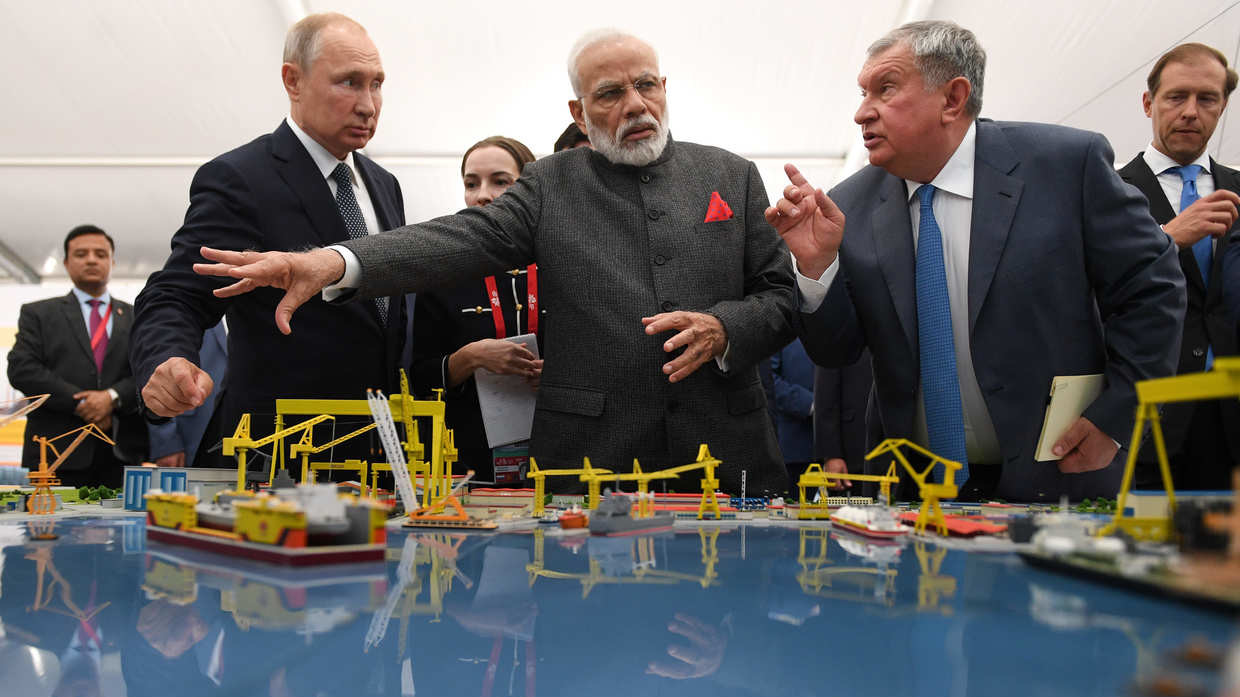Amidst the geopolitical tremors which have emerged since the start of the Ukraine conflict, Russia and India stand at a crucial juncture, showcasing their growing ties as a symbol of diplomatic strength.
Originally grounded in the Indo-Soviet defense partnership, ties between New Delhi and Moscow have relatively recently come to include a lucrative partnership in the energy sector. India has invested in Russian oil and gas, illuminating the robustness of this bilateral relationship.
Russian foreign policy expert Ivan Timofeev’s impactful insights advocate for independent financial mechanisms, wielding significant influence. The energy sector has emerged as the linchpin, anchoring the parties' collaborative future in the face of international complexities.
Despite intensified Western sanctions, trade turnover between India and Russia exceeded $50 billion in 2023, displaying impressive resilience. Russia’s revenue rebound amid the evolving global energy landscape has added depth to its steadfast collaboration with India, highlighting their mutual dedication to overcoming challenges and achieving shared economic objectives.
The bilateral conference held last month in New Delhi by Russia’s Valdai Discussion Club and India’s Vivekananda International Foundation underscored the pivotal role of oil and gas in these bilateral ties.
India’s strategic forays into Russia’s oil and gas sectors paint a picture of impactful investments and energizing bilateral ties; their symbiotic relationship is primed for mutual prosperity across the energy industry’s upstream, midstream, and downstream segments — a testament to collaborative prowess and shared economic ambitions.
At the outset of this upstream venture, India’s Oil and Natural Gas Corporation Videsh (OVL) embarked on a transformative journey, making a $2.1 billion acquisition deal for a UK-based firm, Imperial Energy Corporation, which operated in Russia in 2009. This landmark acquisition opened the gates to Siberia’s oil fields, planting the seeds for India’s upstream activity on Russian soil. OVL holds a 26% stake in the Suzunskoye, Tagulskoye, and Lodochnoye fields, collectively known as the Vankor cluster in the north-eastern part of West Siberia, which yields 7.31 million metric tons of oil. OVL also holds a 20% stake in the Sakhalin-1 oil and gas field located in the Russian Far East.
A consortium comprising Indian Oil Corporation (IOC), Oil India Ltd (OIL), and Bharat PetroResources Ltd, a subsidiary of Bharat Petroleum Corporation Ltd (BPCL), holds a 23.9% stake in the project, investing $2.02 billion. In parallel, Rosneft commands a majority interest of 50.1%, contributing to total oil production of 6.56 million tons.
Moreover, the partnership involving OIL, IOC, and Bharat PetroResources Ltd (BPRL) has secured an extra 29.9% ownership in the Taas-Yuryakh oilfield situated in East Siberia, involving a substantial investment of $1.12 billion.
In a groundbreaking no-cash deal, ONGC merged its Russian assets with Sistema’s Bashneft and RussNeft on June 19, 2011. This provided ONGC access to Trebs & Titov oilfields and a 25% stake in the merged entity.
In 2013, Rosneft offered OVL a stake in the Magadan-2 and Magadan-3 blocks in the northern part of the Okhotsk sea, which is estimated to hold 2.8 billion metric tons of oil and oil equivalent natural gas. Later in 2014, Rosneft also offered OVL a stake in its Yurubcheno-Tokhomskoye oilfield in eastern Siberia, which is estimated to hold 991 million barrels of oil equivalent reserves.
India has firmly positioned itself by embracing liquefied natural gas (LNG) imports from Russia’s Yamal LNG project. A monumental 20-year contract signed between GAIL India Limited and Gazprom in 2018 not only ensured a consistent flow of 2.5 million tons of LNG annually but also forged an unshakable channel in the midstream domain.
This momentous liaison stood as a testament to their energy alliance. In 2021, India celebrated a historic milestone as it welcomed the first direct shipment of Russian LNG under this enduring pact with Gazprom.
India’s achievements in downstream operations have yielded strategic successes in acquiring assets, showcasing exceptional foresight and careful planning. In a monumental move in 2016, Rosneft orchestrated a landmark acquisition, securing an overwhelming 98% stake in India’s Essar Oil for $12.9 billion. This transformative venture gave birth to Nayara Energy (in which Rosneft has a 49.13 percent stake), injecting vitality into India’s energy landscape by overseeing the Gujarat's second-largest single-site refinery, boasting an impressive annual capacity of 20 million tons. Nayara’s aspirations soared even higher in 2021 as it unveiled plans for a cutting-edge 450 kiloton per annum polypropylene plant at the Gujarat refinery, signaling the dawn of a diversified array of energy ventures and marking yet another chapter in India’s downstream triumphs.
These dynamic investments, spanning exploration, production, refining, and distribution, stand as pillars of bilateral collaboration, fortifying India’s energy security, providing Russia with a steadfast market, fostering technological exchange, and heralding a new chapter of economic synergy. Russia’s call for more Indian investment in its oil and gas sector amid sanctions reflects Moscow’s commitment to strengthening economic ties.
Amid geopolitical storms, the two nations have cultivated a bond navigating turbulence with innovative strategies and resilient partnerships, exemplifying cooperation amid an evolving multipolar world order. India’s investments in Russian oil and gas fields symbolize more than transactions; they embody a strategic convergence, fortifying ties, promoting technological exchange, and steering both nations towards a shared future of energy security and economic prosperity.
Where India Meets Russia – We are now on WhatsApp! Follow and share RT India in English and in Hindi



